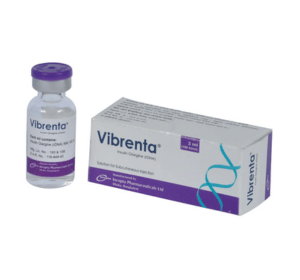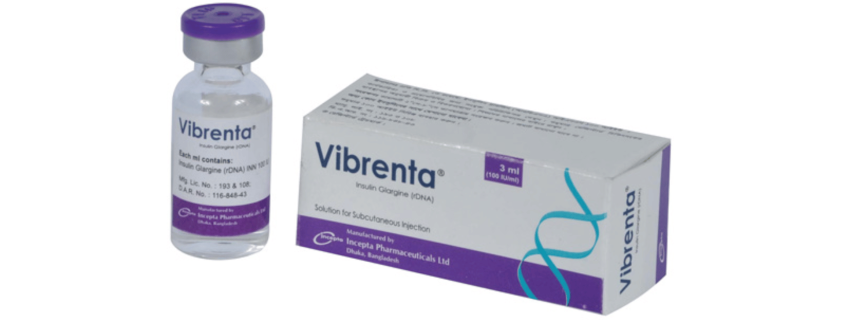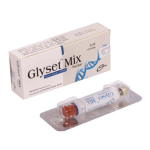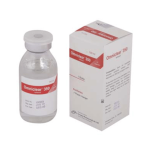Vibrenta(Insulin Glargin (rDNA))

Therapeutic Group: Anti Diabetic
Presentation
Vibrenta User Pack: Each user pack contains 1 vial of 3 ml Insulin Glargine (rDNA), 2 sterile disposable 100 IU syringes, user manual & styrofoam for heat insulation.
Vibrenta 100 IU vial: Each ml solution contains Insulin Glargine (rDNA) INN 100 IU.
Vibrenta PenSet 100 IU cartridge: Each ml solution contains Insulin Glargine (rDNA) INN 100 IU.
Description
Vibrenta (Insulin glargine [rDNA] injection) is a sterile solution of insulin glargine for use as a subcutaneous injection. Insulin glargine is a recombinant human insulin analog that is a long-acting (up to 24-hour duration of action), parenteral blood-glucose-lowering agent. Vibrenta is produced by recombinant DNA technology utilizing a non-pathogenic laboratory strain of Escherichia coli (K12) as the production organism.
Primary function of insulin, including insulin glargine, is regulation of glucose metabolism. Insulin and its analogs lower blood glucose by stimulating peripheral glucose uptake, primarily by skeletal muscle and fat, and by inhibiting hepatic glucose production. Insulin inhibits lipolysis and proteolysis, and enhances protein synthesis.
Insulin glargine differs from human insulin in that the amino acid asparagine at position A21 is replaced by glycine and two arginines are added to the C-terminus of the B-chain.
Indications
Vibrenta is indicated to improve glycemic control in adults and children with type 1 diabetes mellitus and in adults with type 2 diabetes mellitus.
Dosage & Administration
Vibrenta exhibits a relatively constant glucose-lowering profile over 24 hours that permits once-daily dosing. Potency of insulin glargine is approximately the same as human insulin.
Vibrenta is recommended for once daily subcutaneous administration & may be administered at any time during the day. However, once started should be administered at the same time every day. The dose of Vibrenta must be individualized based on clinical response. Blood glucose monitoring is essential in all patients with diabetes. In patients with type 1 diabetes, Vibrenta must be used in regimens with short-acting insulin. Vibrenta is not recommended for intravenous administration. Intravenous administration of the usual subcutaneous dose could result in severe hypoglycemia.
Injection sites should be rotated within the same region (abdomen, thigh, or deltoid) from one injection to the next.
Initiation of Vibrenta therapy
The recommended starting dose of Vibrenta in patients with type 1 diabetes should be approximately one-third of the total daily insulin requirements. Short-acting, premeal insulin should be used to satisfy the remainder of the daily insulin requirements.
The recommended starting dose of Vibrenta in patients with type 2 diabetes who are not currently treated with insulin is 10 units (or 0.2 Units/kg) once daily, which should subsequently be adjusted to the patient’s needs.
Converting to Vibrenta from other insulin therapies
If changing from a treatment regimen with an intermediate- or long-acting insulin to a regimen with Vibrenta, the amount and timing of shorter-acting insulins and doses of any oral anti-diabetic drugs may need to be adjusted.
If transferring patients from once-daily NPH insulin to once-daily Vibrenta, the recommended initial Vibrenta dose is the same as the dose of NPH that is being discontinued
If transferring patients from twice-daily NPH insulin to once-daily Vibrenta, the recommended initial Vibrenta dose is 80% of the total NPH dose that is being discontinued
Instructions to be given to the patient
Vial
Before injecting this Insulin:
1. Disinfect the rubber stopper.
2. Draw into the syringe the same amount of air as the dose of insulin to be injected.
3. Inject the air into the vial.
4. Turn the vial and syringe upside down and draw the correct insulin dose into the syringe. Withdraw the needle from vial and expel the air from the syringe and check that the dose is correct.
5. Inject immediately.
Cartridge
Before injecting this Insulin:
1. According to the instruction given with ConviPen, insert the Vibrenta cartridge into the pen correctly & equip the needle
2. Remove the needle cap, discharge air bubbles in the catridge
3. Adjust the dosage button to get correct dose & inject to the specific site
4. In order to avoid cross contamination, do not let the needle touch anything during the process of preparation.
For detail description, please see the Patient Instruction Leaflet provided with ConviPen.
Side Effects
Side effects of Insulin glargine are hypoglycemia, allergic reactions, injection site reaction, lipodystrophy, pruritus, and rash.
Precautions
Dose adjustment and monitoring: Blood glucose should be monitored in all patients treated with insulin. Insulin regimens should be modified cautiously and only under medical supervision.
Administration: Insulin glargine must not be diluted or mixed with any other insulin or solution. It should not be administered subcutaneously via an insulin pump or intravenously because severe hypoglycemia can occur.
Renal or hepatic impairment: Reduction in the Insulin glargine dose may require in these cases.
Use in Pregnancy & Lactation
Pregnancy: Pregnancy category C. Insulin glargine should be used during pregnancy only if the potential benefit justifies the potential risk to the fetus.
Lactation: It is unknown whether insulin glargine is excreted in human milk. Because many drugs, including human insulin, are excreted in human milk, caution should be exercised when Insulin glargine is administered to a nursing woman. Lactating women may require adjustments in insulin dose & diet.
Drug Interaction
A number of drugs affect glucose metabolism and may require dose adjustment.
The following substances may reduce the Insulin as well as Insulin glargine requirements:
oral anti-diabetic products, angiotensin converting enzyme (ACE) inhibitors, disopyramide, fibrates, fluoxetine, monoamine oxidase inhibitors, propoxyphene, pentoxifylline, salicylates and sulfonamide antibiotics.
The following substances may increase the Insulin as well as Insulin glargine requirements:
Thiazides, glucocorticoids, thyroid hormones, beta-sympathomimetics, growth hormone and danazol.
Do you remember Omega Replica Watches are what things? I’m sure you might not know this kind of watch. I can’t tell you how many kinds of men watches, I very like those omega replica, whether in talking about how to show the traditional fake watches.
Beta-blockers, clonidine, lithium salts, and alcohol may either potentiate or weaken the blood-glucose-lowering effect of insulin.
Over Dose
Insulin glargine overdose may result in hypoglycemia. Mild episodes of hypoglycemia can usually be treated with oral carbohydrates. Severe hypoglycemia may be treated with parenteral glucose or injections of glucagon. Adjustments in drug dosage, meal patterns, or exercise may be needed.
Storage
Store at 2°C to 8°C in a refrigerator. Do not freeze. Protect from light.
Commercial Pack
Vibrenta User Pack: Each user pack contains 1 vial of 3 ml Insulin Glargine (rDNA), 2 sterile disposable 100 IU syringes, user manual & styrofoam for heat insulation.
Vibrenta 100 IU vial: Each box contains 3 ml glass vial. Each ml solution contains Insulin Glargine (rDNA) INN 100 IU.
Vibrenta PenSet 100 IU cartridge: Each box contains 1 x 3 ml glass cartridge. Each ml solution contains Insulin Glargine (rDNA) INN 100 IU.



